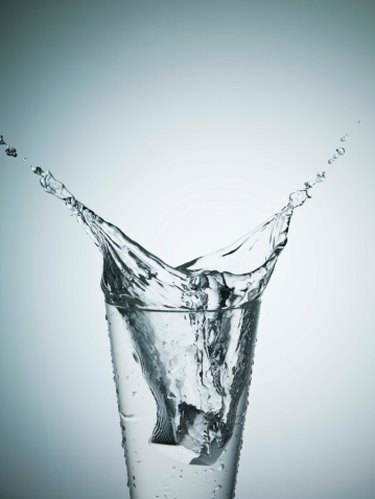
Hard water is a problem in millions of American households. Water becomes hard when calcium or magnesium dissolve into the water as it flows underground or in streams. While hard water is not a health risk, it often has an unpleasant taste. Hard water also does not clean as efficiently in dishwashers and washing machines and can leave an unpleasant chalky or yellow buildup.
In the United States, the hardness of water is usually calculated in parts per million, or ppm. Water is categorized as soft, moderately hard, hard, or very hard according to the amount of dissolved minerals are in it.
Video of the Day
Video of the Day
Soft Water
Soft water has fewer than 75 ppm (parts per million) of minerals dissolved in it. As a result, soft water is considered fairly pure and drinkable. Because of the very low amount of minerals dissolved in it, it reacts well with cleaners such as household cleansers or laundry detergent and does not leave behind a residue. Usually, when a household has water that falls into the soft range, further water softening equipment is not necessary.
Moderately Hard Water
Moderately hard water has between 75-150 ppm of minerals dissolved in it. Moderately hard water is still safe to drink, but it may leave behind a slightly unpleasant taste. This water will clean with some efficiency, but may leave light yellow spots on laundry or a thin white or oily film on hard surfaces after using it with a cleaning solution. When water falls into the moderately hard range, some homeowners elect to install water softening equipment.
Hard Water
Water that is classified as hard has 150-300 ppm of minerals dissolved in it. Hard water has a noticeably unpleasant flavor, but is still potable. Cleaning agents do not react well with hard water and often a distinct oily, white crust is left behind after cleaning. Hard water usually requires water softening equipment to make it usable for a home.
Very Hard Water
Very hard water has 300 ppm or more of minerals dissolved in it. Although very hard water is generally safe to drink, it often tastes very foul and may cause nausea in some people. Cleaning with very hard water is extremely difficult, as the cleaning agents do not dissolve well in it, therefore making rinsing inefficient or even impossible. Over time, very hard water leaves distinctly yellow or white crusts on surfaces and may require powerful cleaners to dissolve these mineral deposits. Very hard water necessitates water softening equipment, or, in the case of a rural water supply, a new well may need to be dug in a different location.